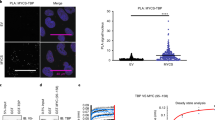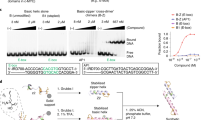Abstract
The C-terminal region of the c-MYC transcription factor consists of approximately 100 amino acids that in its native state does not adopt a stable structure. When this region binds to the obligatory partner MAX via a coupled folding-and-binding mechanism, it forms a basic-helix-loop-helix–leucine zipper (bHLHZip) heterodimeric complex. The C-terminal region of MYC is the target for numerous drug discovery programs for direct MYC inhibition via blocking the dimerization event and/or binding to DNA, and a proper understanding of the partially folded, dynamic nature of the heterodimeric complex is essential to these efforts. The bHLHZip motif also drives protein–protein interactions with cofactors that are crucial for both transcriptional repression and activation of MYC target genes. Targeting these interactions could potentially provide a means of developing alternative approaches to halt MYC functions; however, the molecular mechanism of these regulatory interactions is poorly understood. Herein we provide methods to produce high-quality human c-MYC C-terminal by itself and in complex MAX, and how to study them using Nuclear Magnetic Resonance spectroscopy and X-ray crystallography. Our protein expression and purification protocols have already been used to study interactions with cofactors.
Access this chapter
Tax calculation will be finalised at checkout
Purchases are for personal use only
Similar content being viewed by others
References
Carroll PA, Freie BW, Mathsyaraja H, Eisenman RN (2018) The MYC transcription factor network: balancing metabolism, proliferation and oncogenesis. Front Med 12(4):412–425. https://doi.org/10.1007/s11684-018-0650-z
Nepal RM, Martin A (2019) Unmasking the mysteries of MYC. J Immunol 202(9):2517–2518. https://doi.org/10.4049/jimmunol.1900186
Kortlever RM, Sodir NM, Wilson CH, Burkhart DL, Pellegrinet L, Brown Swigart L, Littlewood TD, Evan GI (2017) Myc cooperates with Ras by programming inflammation and immune suppression. Cell 171(6):1301–1315. https://doi.org/10.1016/j.cell.2017.11.013
Hann SR (2014) MYC cofactors: molecular switches controlling diverse biological outcomes. Cold Spring Harb Perspect Med 4(9):a014399. https://doi.org/10.1101/cshperspect.a014399
Gabay M, Li Y, Felsher DW (2014) MYC activation is a hallmark of cancer initiation and maintenance. Cold Spring Harb Perspect Med 4(6):a014241. https://doi.org/10.1101/cshperspect.a014241
Dang CV (2012) MYC on the path to cancer. Cell 149(1):22–35. https://doi.org/10.1016/j.cell.2012.03.003
Sodir NM, Swigart LB, Karnezis AN, Hanahan D, Evan GI, Soucek L (2011) Endogenous Myc maintains the tumor microenvironment. Genes Dev 25(9):907–916. https://doi.org/10.1101/gad.2038411
Wolfram JA, Lesnefsky EJ, Hoit BD, Smith MA, Lee H-g (2011) Therapeutic potential of c-Myc inhibition in the treatment of hypertrophic cardiomyopathy. Ther Adv Chronic Dis 2(2):133–144. https://doi.org/10.1177/2040622310393059
McKeown MR, Bradner JE (2014) Therapeutic strategies to inhibit MYC. Cold Spring Harb Perspect Med 4(10):a014266. https://doi.org/10.1101/cshperspect.a014266
Allen-Petersen BL, Sears RC (2019) Mission possible: advances in MYC therapeutic targeting in cancer. BioDrugs 33(5):539–553. https://doi.org/10.1007/s40259-019-00370-5
Whitfield JR, Beaulieu M-E, Soucek L (2017) Strategies to inhibit Myc and their clinical applicability. Front Cell Dev Biol 5:10. https://doi.org/10.3389/fcell.2017.00010
Zinzalla G (2016) Targeting MYC: is it getting any easier? Future Med Chem 8(16):1899–1902. https://doi.org/10.4155/fmc-2016-0119
Nair SK, Burley SK (2003) X-ray structures of Myc-Max and Mad-Max recognizing DNA. Molecular bases of regulation by proto-oncogenic transcription factors. Cell 112(2):193–205
Sammak S, Hamdani N, Gorrec F, Allen MD, Freund SMV, Bycroft M, Zinzalla G (2019) Crystal structures and nuclear magnetic resonance studies of the Apo form of the c-MYC:MAX bHLHZip complex reveal a helical basic region in the absence of DNA. Biochemistry 58(29):3144–3154. https://doi.org/10.1021/acs.biochem.9b00296
Sabò A, Amati B (2014) Genome recognition by MYC. Cold Spring Harb Perspect Med 4(2):a014191. https://doi.org/10.1101/cshperspect.a014191
Lorenzin F, Benary U, Baluapuri A, Walz S, Jung LA, von Eyss B, Kisker C, Wolf J, Eilers M, Wolf E (2016) Different promoter affinities account for specificity in MYC-dependent gene regulation. eLife 5:e15161. https://doi.org/10.7554/eLife.15161
Tu WB, Helander S, Pilstal R, Hickman KA, Lourenco C, Jurisica I, Raught B, Wallner B, Sunnerhagen M, Penn LZ (2015) Myc and its interactors take shape. Biochim Biophys Acta 1849(5):469–483. https://doi.org/10.1016/j.bbagrm.2014.06.002
Vervoorts J, Luscher-Firzlaff J, Luscher B (2006) The ins and outs of MYC regulation by posttranslational mechanisms. J Biol Chem 281(46):34725–34729. https://doi.org/10.1074/jbc.R600017200
Sammak S, Allen MD, Hamdani N, Bycroft M, Zinzalla G (2018) The structure of INI1/hSNF5 RPT1 and its interactions with the c-MYC:MAX heterodimer provide insights into the interplay between MYC and the SWI/SNF chromatin remodeling complex. FEBS J 285:4165–4180. https://doi.org/10.1111/febs.14660
Herold S, Wanzel M, Beuger V, Frohme C, Beul D, Hillukkala T, Syvaoja J, Saluz HP, Haenel F, Eilers M (2002) Negative regulation of the mammalian UV response by Myc through association with Miz-1. Mol Cell 10(3):509–521. https://doi.org/10.1016/s1097-2765(02)00633-0
Chen H, Venkat S, McGuire P, Gan Q, Fan C (2018) Recent development of genetic code expansion for posttranslational modification studies. Molecules 23(7):1662. https://doi.org/10.3390/molecules23071662
Castell A, Yan Q, Fawkner K, Hydbring P, Zhang F, Verschut V, Franco M, Zakaria SM, Bazzar W, Goodwin J, Zinzalla G, Larsson L-G (2018) A selective high affinity MYC-binding compound inhibits MYC:MAX interaction and MYC-dependent tumor cell proliferation. Sci Rep 8(1):1–17. https://doi.org/10.1038/s41598-018-28107-4
Tan S, Kern RC, Selleck W (2005) The pST44 polycistronic expression system for producing protein complexes in Escherichia coli. Protein Expr Purif 40(2):385–395. https://doi.org/10.1016/j.pep.2004.12.002
Selleck W, Tan S (2008) Recombinant protein complex expression in E. coli. Curr Protoc Protein Sci Chapter 5:Unit 5.21. https://doi.org/10.1002/0471140864.ps0521s52
https://www2.mrc-lmb.cam.ac.uk/groups/JYL/WWWrobots/robot-overview.html
Gorrec F, Zinzalla G (2018) The MORPHEUS III protein crystallization screen: at the frontier of drug discovery. https://www.iucr.org/news/newsletter/volume-26/number-1/the-morpheus-iii-crystallization-screen-at-the-frontier-of-drug-discovery
Jung Y-S, Zweckstetter M (2004) Mars - robust automatic backbone assignment of proteins. J Biomol NMR 30(1):11–23. https://doi.org/10.1023/B:JNMR.0000042954.99056.ad
Favier A, Brutscher B (2011) Recovering lost magnetization: polarization enhancement in biomolecular NMR. J Biomol NMR 49(1):9–15. https://doi.org/10.1007/s10858-010-9461-5
Hu J, Banerjee A, Goss DJ (2005) Assembly of b/HLH/z proteins c-Myc, Max, and Mad1 with cognate DNA: importance of protein-protein and protein-DNA interactions. Biochemistry 44(35):11855–11863. https://doi.org/10.1021/bi050206i
Author information
Authors and Affiliations
Corresponding author
Editor information
Editors and Affiliations
Rights and permissions
Copyright information
© 2021 Springer Science+Business Media, LLC, part of Springer Nature
About this protocol
Cite this protocol
Zinzalla, G. (2021). Biophysical and Structural Methods to Study the bHLHZip Region of Human c-MYC. In: Soucek, L., Whitfield, J. (eds) The Myc Gene. Methods in Molecular Biology, vol 2318. Humana, New York, NY. https://doi.org/10.1007/978-1-0716-1476-1_3
Download citation
DOI: https://doi.org/10.1007/978-1-0716-1476-1_3
Published:
Publisher Name: Humana, New York, NY
Print ISBN: 978-1-0716-1475-4
Online ISBN: 978-1-0716-1476-1
eBook Packages: Springer Protocols




